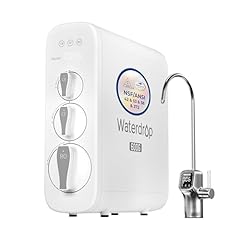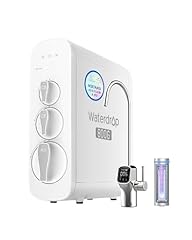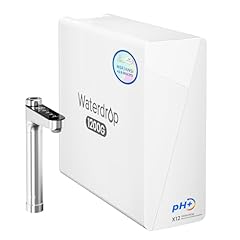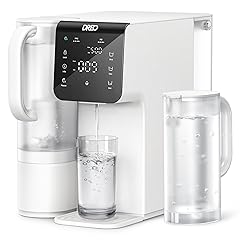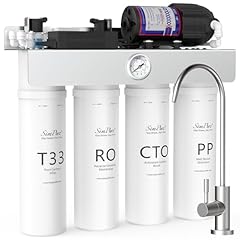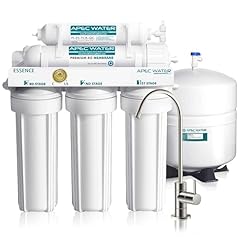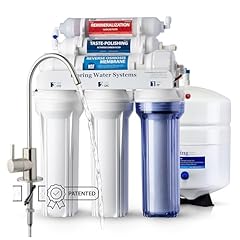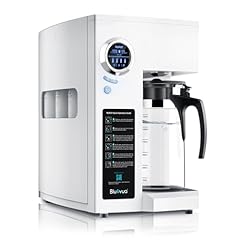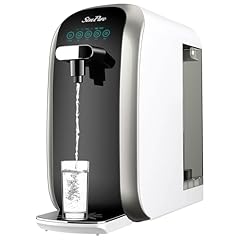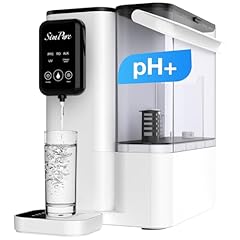-
1
Best Overall Highly efficient 2:1 pure to drain ratio
Highly efficient 2:1 pure to drain ratio Smart LED faucet enhances usability
Smart LED faucet enhances usability Tankless design saves space under sink
Tankless design saves space under sink -
2
 Fast 800 GPD water flow rate
Fast 800 GPD water flow rate Tankless design saves under-sink space
Tankless design saves under-sink space Smart faucet with LED purifier
Smart faucet with LED purifier -
3
 1200 GPD fast flow for high water demand.
1200 GPD fast flow for high water demand. 11-stage filtration ensures superior water purity.
11-stage filtration ensures superior water purity. Alkaline mineral addition improves water quality.
Alkaline mineral addition improves water quality. -
4
Best Affordable Easy setup with no installation required.
Easy setup with no installation required. Efficient filtration with 3:1 water ratio.
Efficient filtration with 3:1 water ratio. Portable design perfect for home kitchens.
Portable design perfect for home kitchens. -
5
Hot Deal High water output with 400 GPD capacity.
High water output with 400 GPD capacity. Advanced 8-stage filtration ensures near 0 TDS.
Advanced 8-stage filtration ensures near 0 TDS. Built-in pump for consistent water pressure.
Built-in pump for consistent water pressure. -
6
 Provides clean, great-tasting water consistently.
Provides clean, great-tasting water consistently. Easy to install and maintain at home.
Easy to install and maintain at home. Five-stage filtration for superior water purity.
Five-stage filtration for superior water purity. -
7
 pH+ remineralization for better tasting water.
pH+ remineralization for better tasting water. NSF certified for reliable water filtration.
NSF certified for reliable water filtration. Easy under-sink installation and maintenance.
Easy under-sink installation and maintenance. -
8
 User-friendly countertop setup with no installation required.
User-friendly countertop setup with no installation required. 6-stage purification ensures exceptionally clean water.
6-stage purification ensures exceptionally clean water. Portable design perfect for home or office use.
Portable design perfect for home or office use. -
9
Popular No installation needed, easy to set up.
No installation needed, easy to set up. High 4:1 pure to drain water ratio.
High 4:1 pure to drain water ratio. Certified for safety and efficiency.
Certified for safety and efficiency. -
10
 Alkaline remineralization enhances water taste.
Alkaline remineralization enhances water taste. Super fast filtering at 300 GPD.
Super fast filtering at 300 GPD. Portable design fits any countertop space.
Portable design fits any countertop space.
Overview of Reverse Osmosis Filter
Ever noticed the lingering taste of chlorine in your tap water, or that unsightly film on your glassware? It's due to impurities that sneak into your water supply, and that's where a reverse osmosis filter can be your secret weapon. It's not just about taste and aesthetics, but health too. We've delved into the world of these ingenious devices, exploring their inner workings, efficiency, and the value they bring to your home. We've employed a rigorous research methodology, examining factors like filtration capabilities, ease of installation, and lifespan. We've assessed how well they can tackle the pesky contaminants and turn your tap water into a crystal-clear, refreshing drink. We're excited to share our findings with you. So, whether you're a health enthusiast, a concerned parent, or someone who appreciates a good glass of water, we've found the top reverse osmosis filters to cater to your unique needs. Stay tuned for our top picks below.Top Reverse Osmosis Filter
• Waterdrop G3 Tankless Reverse Osmosis System• Waterdrop G3P800 Tankless RO System• Waterdrop X12 1200 GPD Tankless RO SystemFAQ
Q: Why should I choose a reverse osmosis filter over other types of water filters?
A: A reverse osmosis filter is known to be one of the most effective methods for filtering water. It can remove up to 99% of contaminants, including lead, fluoride, chlorine, and bacteria, providing you with clean, safe, and great tasting water.
Q: How often do I need to replace the filters in my reverse osmosis system?
A: The frequency of filter changes in a reverse osmosis filter system depends on the quality of your water and your system's specific model. However, as a general rule, pre-filters and post-filters should be replaced every 6-12 months, while the RO membrane itself usually lasts 2-3 years.
Q: Can I install a reverse osmosis filter system myself?
A: Yes, many homeowners are able to install a reverse osmosis filter system on their own. However, if you're not confident in your plumbing skills, you might prefer to hire a professional to ensure the system is installed correctly and safely.
Q: What is the impact of a reverse osmosis filter on the environment?
A: While a reverse osmosis filter does produce some wastewater, it's significantly less than the amount produced by bottled water companies. By choosing a reverse osmosis filter, you're reducing plastic waste and energy consumption associated with bottled water.
Q: How much does a typical reverse osmosis filter cost?
A: The cost of a reverse osmosis filter can vary widely depending on the specific model and its features. However, you can typically expect to pay between $150 and $600 for a system, plus the cost of replacement filters and possible installation fees.

